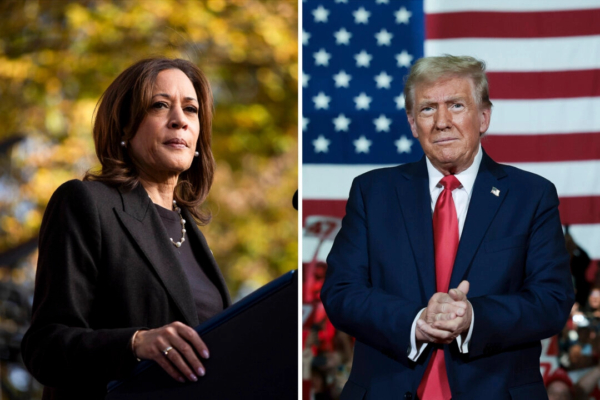Direct translation
Reporter : Jack Phillips/Compiled by Chen Ting / https://www.epochtimes.com/b5/24/11/1/n14362315.htm / Image : Left: On 18 October 2024, Democratic presidential candidate Kamala Harris spoke at a campaign event in Grand Rapids, Michigan. Right: On October 20, 2024, Republican presidential candidate Trump took the stage at a town hall campaign event held at the Lancaster County Convention Center in Lancaster, Pa. (Bill Pugliano, Win McNamee/Getty Images)

A poll analysis by TIPP Insights shows that the competition between Trump and Kamala Harris is very fierce, but based on Trump’s popularity among African-American voters, his vote share could break the deadlock and swing the election in his favour.
According to an analysis report released by the US polling agency TIPP Insights on Thursday (31 October 2024), Trump and Harris each have an approval rating of 48%.
The poll showed that Trump "made significant progress" among African-American voters, with his vote share increasing by 8.1 percentage points and among voters with high school degrees, by 13.9 percentage points. In addition, Trump also made progress among people over 65 years old, with his vote share increasing by 8 percentage points.
"Trump's gains among minority voters could break the current deadlock," TIPP wrote in the report.
The pollster did not say whether Harris or Trump made gains among other minority groups, such as Latinos, Asian Americans or Native Americans. However, TIPP pointed out that the increase and decrease in the support of the two candidates can best be seen from the perspective of education level.
According to TIPP data, Harris' support among college-educated voters increased by 6.3 percentage points and her support among neutral voters increased by 5 percentage points.
According to TIPP data, Trump cannot win the popular vote because the Democratic Party still has significant advantages in New York and California, while the Republican-dominated Texas can only "partially offset" the population advantages of these two states.
"National polls reflect this imbalance, with a large number of blue state voters tilting the numbers toward the Democrats. But in the Electoral College, the popular vote is irrelevant." The analysis pointed out that in 2020, even if Trump won the popular vote he lost about 4.5%, but in the three swing states, as long as he won about 45,000 more votes, he might win the presidential election that year.
"Some media ignored this key fact and hyped up the idea that Trump could not win," the polling agency said. "What are the facts? The election is still very close."
A RealClearPolitics compilation of recent national polls shows that as of Thursday afternoon, Trump had a 0.5 percentage point advantage over Herkins. Compared with polls from the same period in 2020, Democratic candidate Biden's advantage over Trump at that time was 8 percentage points. In 2016, Democratic candidate Hillary Clinton led Trump by 5.9 percentage points.
RealClearPolitics' aggregation shows Trump leading by an average of about 1 percentage point in seven battleground states: Pennsylvania, Michigan, Wisconsin, Arizona, Nevada, North Carolina and Georgia.
In 2020, Biden led Trump by an average of 4 points in these states, while Clinton had a 5-point advantage in 2016.
Third-party candidates also accounted for a share of the overall support. TIPP pointed out that Green Party candidate Jill Stein received 0.9% support and independent candidate Cornell West received 1% support. About 1.7% of respondents said they were still unsure who to vote for.
So far, voters appear to be heeding the call to vote early. Registered Republican voters headed to the polls to cast their ballots in person ahead of Election Day, with record early turnout in battleground states such as Georgia and North Carolina.
Statistics from the UF Election Lab show that as of 11.22 p.m. ET on Thursday, about 65 million people had cast early votes, including more than 34 million early in-person votes and nearly 31 million Mail-in ballots.
More than two dozen states have counted the number of early voters by political party. Slightly more registered Democrats have voted so far, about 12.33 million. Meanwhile, about 11.6 million registered Republican voters have already cast their ballots, data shows.
Election data compiled by the university shows that among early voters, about 4.6 million were Republicans, about 1 million more votes than Democrats. About 8.3 million Democrats have returned mail-in ballots so far, compared with only about 6.5 million Republicans. About 19.3 million Democrats have applied for mail-in ballots, while Republicans have applied for about 13.6 million.
As the election day approaches, both Trump and Harris are planning a series of campaign activities, hoping to step up their sprint in the final stage to gain the support of more voters.




No comments:
Post a Comment